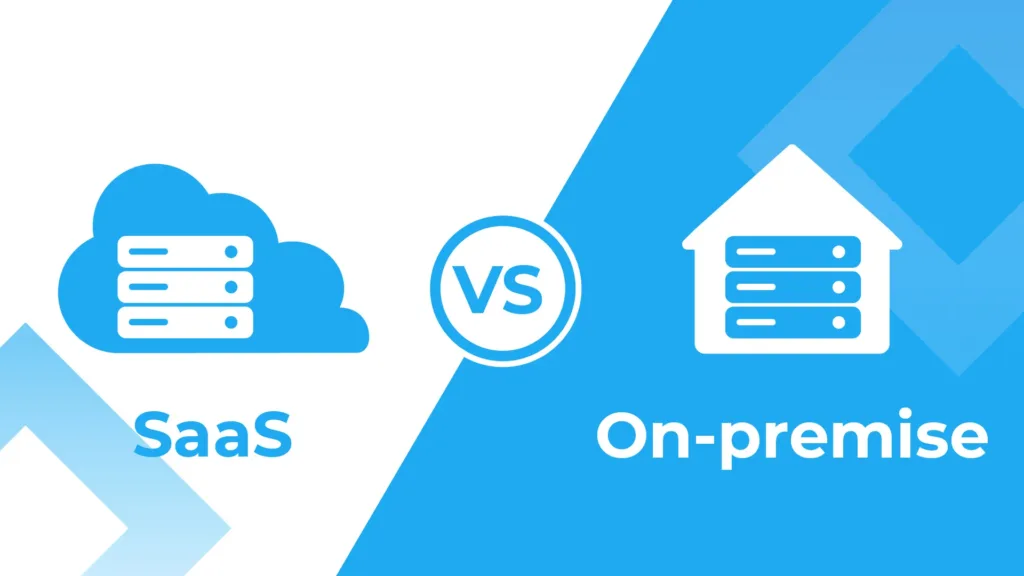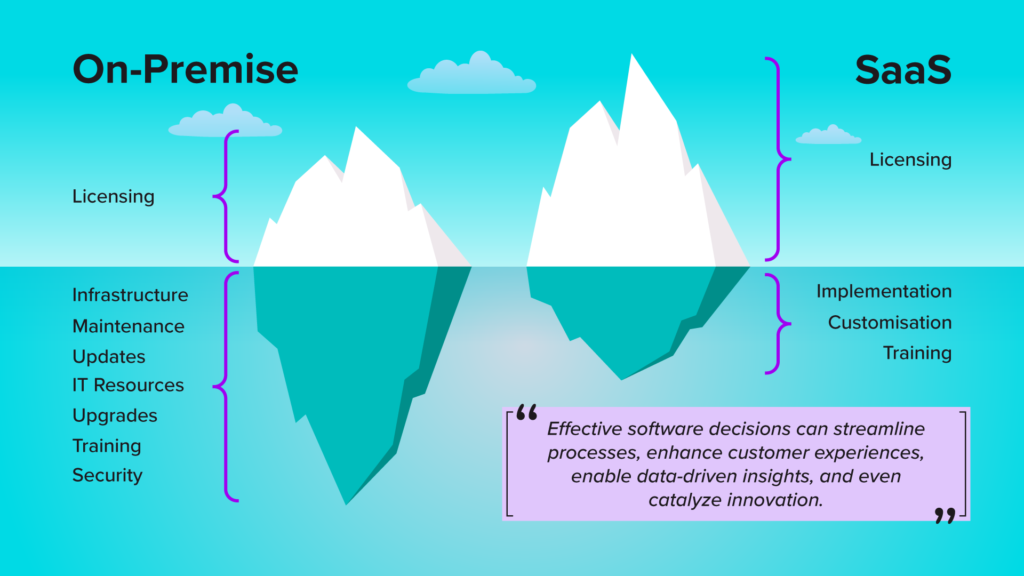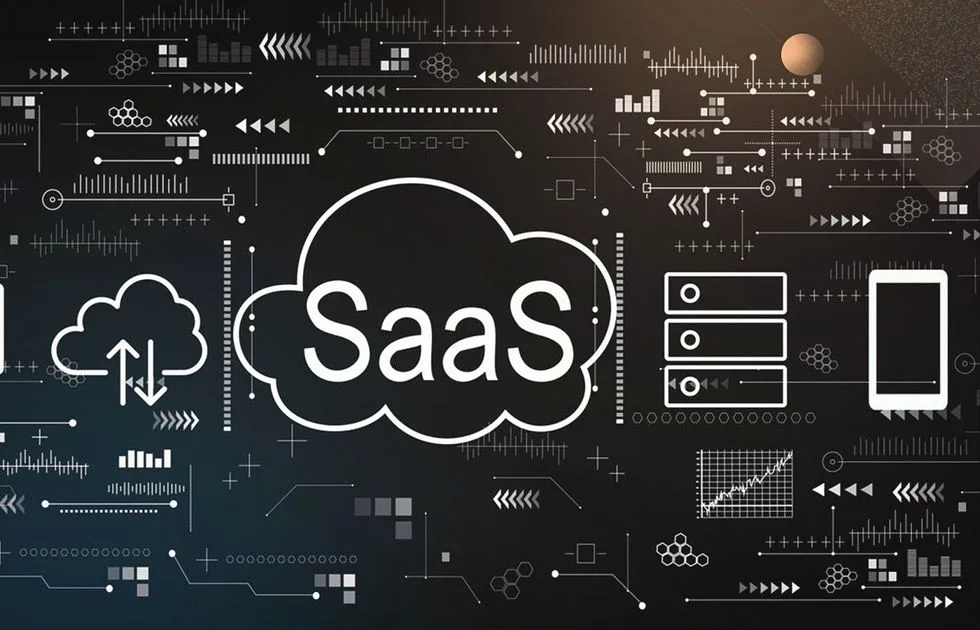
SaaS vs On-Premise represent two distinct approaches to deploying and running business software.
With an on-premises setup, the organization purchases and installs the software within its own data centers. The internal IT team is responsible for managing every aspect of the infrastructure—from procuring and maintaining server hardware to configuring and updating operating systems, as well as installing and upgrading necessary add-ons or plugins.
SaaS, on the other hand, is a cloud-delivered model where applications are accessed directly through a web browser. The service provider hosts and manages the software, handling all updates, security, and infrastructure needs. This allows organizations to focus entirely on how they use the software rather than how it is maintained.
Implementation Differences: SaaS vs On-Premises

On-premises software requires complex setup and infrastructure oversight, whereas Software as a Service (SaaS) largely removes those burdens. Below are key differences in how each is implemented.
1. Cost
With an on-premises solution, the organization handles every stage of setup, deployment, and ongoing maintenance. This often involves purchasing servers and other IT infrastructure, hiring technical staff to manage systems and troubleshoot issues, and covering future upgrade costs. Procuring and configuring these resources also takes significant time, further driving up expenses. As a result, on-premises deployments are generally more expensive to establish and maintain.
By contrast, SaaS software runs on infrastructure managed by an external provider. Businesses typically pay on a subscription basis, only covering the resources they consume. Since there’s no need to purchase or install hardware, SaaS offers a lower barrier to entry and faster implementation.
2. Customization
On-premises solutions offer full control over infrastructure and software, enabling extensive customization. Organizations can integrate internal systems, add bespoke features, or build hardware capabilities into existing machines. However, this flexibility often comes with higher costs.
SaaS solutions provide customization in a different way. While you cannot modify the physical infrastructure, you can choose different subscription tiers and adjust configurations to suit your needs. Many SaaS products offer robust feature sets and can be configured to fit most use cases. In most cases, organizations can start using SaaS tools immediately after subscribing.
3. Ongoing Support
With on-premises systems, the organization is solely responsible for support. Tasks such as troubleshooting, bug fixes, infrastructure management, and software updates require hiring and training IT staff, which adds salary and development expenses.
SaaS providers, on the other hand, include technical support as part of their service. They handle maintenance, updates, and infrastructure issues, allowing customers to focus on using the software rather than maintaining it.
4. Security
On-premises deployments give businesses complete control over security configurations, allowing them to tailor cybersecurity measures to their own standards. However, this also requires constant monitoring and updates to stay secure.
SaaS vendors typically serve a global customer base, prompting heavy investment in advanced security measures. Many maintain dedicated security teams that actively monitor threats and protect data. As with any service, the security level depends on the provider, so it’s best to partner with trusted vendors.
SaaS vendors provide service level agreements (SLAs) that grant customers specific legal and contractual protections. These agreements outline the key terms for using the SaaS product, detailing factors such as guaranteed uptime, security commitments, available support levels, and responsibilities for delivering software updates.
5. Backup
On-premises systems allow organizations to decide how and when backups occur. Businesses can customize backup schedules, techniques, and storage locations, but they must ensure offsite backups to protect against hardware failures or disasters.
Most SaaS solutions come with built-in, automated backup and disaster recovery systems. Because SaaS providers operate at large scale, they usually implement comprehensive recovery and risk mitigation strategies to keep customer data safe. Organizations should review a provider’s backup policies before adopting the service.
Additional differences between SaaS and on-premises deployments
Apart from the core contrasts between software as a service (SaaS) and on-premises solutions, there are several other factors that further separate the two models.
- Scalability
Although on-premises systems can be scaled, doing so comes at a significant cost. Expanding capacity requires purchasing and installing additional hardware, which takes both time and money. If your business encounters sudden traffic spikes, you can’t simply scale on demand—you must either invest heavily upfront and risk underutilized resources or wait for new equipment to arrive.
By comparison, SaaS platforms offer near-instant scalability. You can simply adjust your subscription plan to unlock additional resources immediately, eliminating the delays and high costs associated with hardware upgrades. This makes responding to changing demands seamless and efficient.
- Accessibility
With on-premises software, you’re responsible for maintaining the network infrastructure needed to ensure employee access. For global teams, this might mean running multiple deployments in different data centers, each of which requires ongoing updates and maintenance to provide a uniform user experience.
SaaS solutions, on the other hand, are designed with accessibility at their core. Employees can log in from virtually any location using a web browser or a dedicated app, giving teams easy and consistent access without complex networking requirements.
- Analytics
On-premises environments only offer the analytical tools you choose to integrate, providing flexibility but also requiring additional investment. You may need to hire specialists to develop custom dashboards, reports, and data pipelines tailored to your needs.
SaaS platforms typically come equipped with built-in analytics suites or seamless integrations with reporting tools, often bundled into the subscription or available as optional add-ons. While you may have less freedom to modify the analytics tools themselves, you can customize your plan to fit the level of insight you require without building everything from scratch.
Conclusion
Choosing between SaaS and on-premise software ultimately comes down to your organization’s priorities, resources, and long-term goals. SaaS offers speed, scalability, and convenience with lower upfront costs, while on-premise solutions provide greater control, customization, and security oversight. By evaluating your technical capabilities, budget, and compliance requirements, you can determine which model aligns best with your business strategy and ensures sustainable growth.

